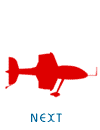
Current Status
27 April 2011Hummingbird has been on the backburner for a couple of years while I have buried myself in esoteric physics.
First, if anybody is contemplating using FloWorks for external flows, forget about meaningful force and moment data. I couldn't do better than a factor of two in 2D airfoil simulations. There are also bugs in moment data reporting for mirrored cases. I have yet to see good external data from FloWorks - has anyone? Perhaps SW Corp should cease from promoting FloWorks as applicable to "flow over an aircraft wing" or face the wrath of (a subset of) its users...
Consequently I have installed OpenFoam and was happily learning it before getting all caught up in physics.
The images below depict a configuration change that has been around for a while and is instructive to explain. The long main gear was always going to be difficult (though in fact it is just a tad longer than the SU26/31 and HB is lighter). Many people have suggested a duct mounted gear over the years but I resisted to avoid increased prop tip clearances. Thinking changed when it became evident that bracing the duct's trailing edge alone could result in a divergent structural condition, the outboard wings increasing AoA with G. Since resultant loads from the outboard wings almost coincide with 45 deg bracing at the duct leading edge, torsional deflections become minimal.
Attaching the titanium spring to the duct and strut will be tricky but probably easier than the long gear. Struts could be placed above as well but probably are unnecessary. The struts may well introduce less turbulence into the duct inflow than would the long gear legs, since separation from the struts at high AoA will be delayed by their location in the duct flowfield.
Notice also the use of just three stators, optimum (in terms of aerodynamics and engine packaging) now that wing bending loads are taken through the leading edge struts.
8 May 2009
Moved site to esotec.org and added Software page.
With the software complete the next step is Hummingbird CFD.
New (big) machine arriving any day to run FloWorks.
As of 16 Feb 2009
The configuration continues to evolve as data comes in and understanding is gained. Tricky stuff but no show stoppers. Current efforts are concentrated on pinning down aero lines for CFD.
Effective CFD and FEA analysis tools are finally coming together. Check out the new DFDC page (Ducted Fan Design Code). This program is providing the first rigorous look at Hummingbird's unique propulsion system, with predictions better than expected.
As of 02 April 2008
Recently I returned to Hummingbird development full time after a hiatus of some six years while completing another major project. A significant adjustment to the configuration has led to a series of technical breakthroughs retiring key obstacles. The aircraft stands fully defined, including all systems, and the way forward is clear.
Currently I am assembling the CFD and FEA tools needed to rigorously analyse and optimize Hummingbird's aerodynamics, structures and systems. Keep an eye on this site: there will be many interesting developments appearing over the coming months.
As of 29 April 2006
The Hummingbird Configuration has flown.
See the new Radio-Controlled Model page for some details of Patrizio Bronzi's scale electric model.
A STATEMENT
Research and Development of the Hummingbird Concept is continuing as time and resources permit, and has moved well beyond what is detailed on this site. During the 7 years that this site has been online I have received countless expressions of interest and encouragement, and much useful technical comment. In particular, the peer-review has been invaluable, which is indeed one of the key purposes of publishing the concept in detail.
My motivation for this work is not to sell an idea or to get rich, but to present a technical argument which points to the aerobatics of the future. If this argument stands, then the day will come when every unlimited class aerobatic aircraft will look something like Hummingbird.
Unlike most new aircraft, Hummingbird returns to fundamental physics to redefine how an aerobatic aircraft should be configured. This in turn has forced a re-analysis of what aerobatics is. This is the scientific aspect of the project, which stands intact.
The implementation of the configuration, thus derived, enters into the realm of engineering, which is the process currently at hand. Being unlike any other aircraft ever devised, there are a host of unique engineering problems to solve, simplify and optimize. For the aircraft to reach its potential, the technical elegance of the configuration must be matched by an equally elegant implementation.
It is for this reason that I have turned down several opportunities to "just build one" and see what happens. Rather, I have chosen to focus my attention on the many subtle details involved in creating a rugged, reliable, sweet-handling, optimized machine. The Hummingbird Configuration is especially unforgiving of a haphazard approach.
My goal is that any pilot who flies Hummingbird will never want to go back. And the aircraft will never, ever, let him or her down.
When the opportunity arises to manifest the machine in physical matter, I will be ready. The science stands timelessly, and I am in no hurry.
Philip
29 April 06
As of 20 July 2004
Hummingbird has been on the backburner while I complete a major (unrelated) project. Activity has been limited to studying the influence of the propulsion system on the tail surfaces. This is a complex subject since high power settings will "straighten" the downwash at the tail (decreasing stability) while significantly increasing velocities (increasing stability). A related issue is airflow over the tail being disturbed when the propellers are producing drag. Since CFD studies of these complex interactions are difficult, wind-tunnel or RC model testing will likely be required to deepen our understanding of the phenomena.
Hummingbird has been delayed, but it's not going away.
As of 13 October 2002
ESOTEC has entered into a collaborative effort with Haute Voltige to assemble the resources and infrastructure required to build a Hummingbird prototype and develop the aircraft to production status. This organisation seeks to advance aerobatics as a performing art and is thus a perfect fit with the Hummingbird paradigm.
As of 27 June 2002
The past year has seen activity in three major areas:
- Ongoing studies and detail design of propeller hubs and pitch actuation systems.
- An ongoing search for optimum engines.
- Sourcing funding to develop and build a Hummingbird prototype
As of 15 May 2001
The Hummingbird Program has recently been relocated to New Zealand and is currently at the detail design stage.
The following tasks have been completed or are at an advanced stage of development:
- Configuration optimization.
- Airfoil section development for wings, duct, and propellers.
- Optimization of wing and duct geometry.
- Fuselage geometry (1 and 2 seat versions).
- Propeller aerodynamic design and analysis.
- Development of custom software suite for transformation of airfoil coordinates and propeller geometries, facilitating rapid and aerodynamically precise lofting of complex 3D flying surfaces and propeller blades.
- Airframe structural configuration.
- Propeller hub and blade structural systems.
- Identifying optimum fibers and prepreg systems for tooling and primary structure.
- Sourcing FEA software for detailed structural analysis of airframe and propellers.
- Detail design of propeller hub structures and electro/mechanical pitch actuation systems.
- Detail design of propeller axle and bearing analysis/selection.
- Continued research into candidate engines.
- Identifying key personnel.
- Sourcing development funding.



© Copyright 1992-2009 Philip Carter